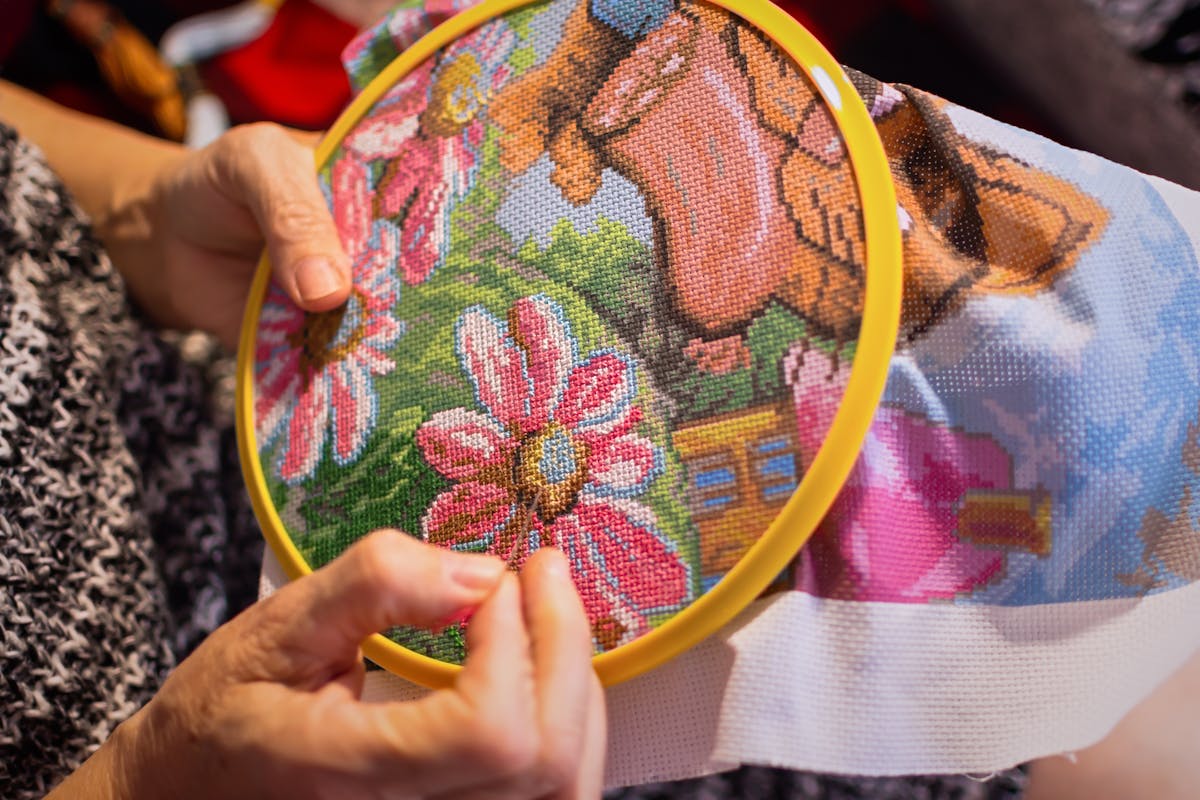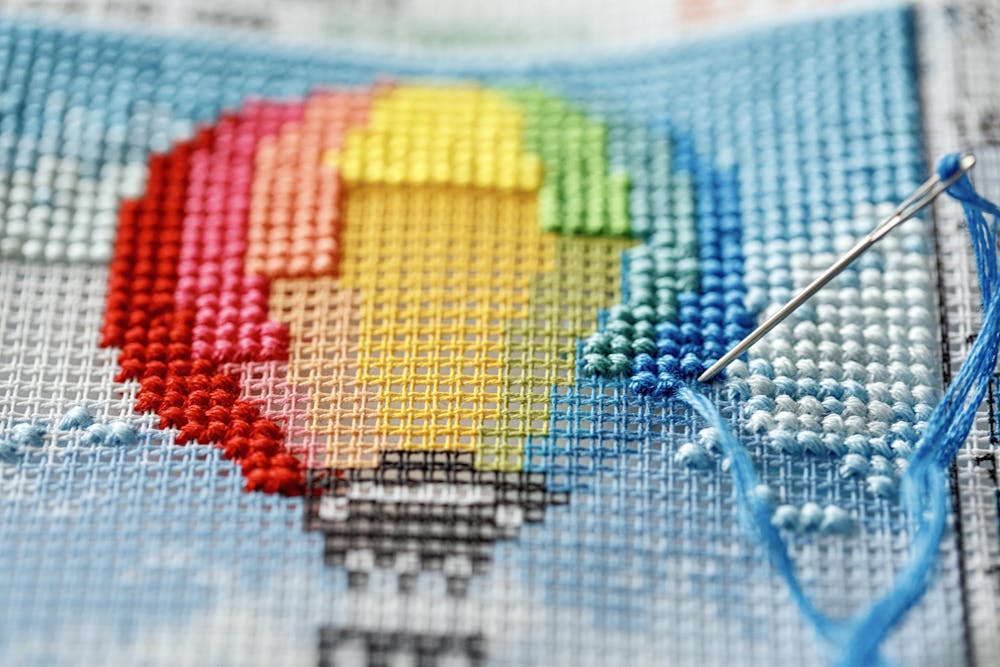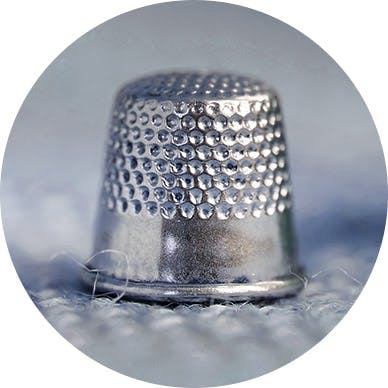Are you a fan of handcrafted textiles? Have you ever wondered about the difference between cross stitch and embroidery? Both techniques can create stunning and intricate designs on fabric, but there are some key distinctions to consider. In this article, we will delve into the world of cross stitch and embroidery, exploring their basics, materials, techniques, time investment, and practical applications. By the end of this comparison, you will have a deeper understanding of which technique is right for you.

Understanding the Basics of Cross Stitch and Embroidery
Embroidery is a timeless art form that has been practiced for centuries. It is a craft that involves decorating fabric using a needle and thread, and it has evolved into various techniques and styles. Two popular forms of embroidery are cross stitch and traditional embroidery.
What is Cross Stitch?
Cross stitch is a specific type of embroidery that uses X-shaped stitches to create a design. It is often done on Aida cloth, a fabric with visible holes that guide the placement of the needle. This makes it easier for beginners to learn and follow patterns.
One of the great advantages of cross stitch is its simplicity. The pattern is usually provided on a grid chart, where each symbol represents a different color of floss. It's like painting by numbers but with threads! This technique is perfect for beginners who want to create beautiful designs.
While cross stitch may seem straightforward, it offers endless possibilities for creativity. From small samplers to intricate tapestries, cross stitch can be used to create stunning works of art. The repetitive nature of the stitches can also be quite therapeutic, making it a popular craft for relaxation and stress relief.
What is Traditional Embroidery?
Traditional embroidery, also known as surface embroidery, encompasses a wide range of stitching styles and techniques. Unlike cross stitch, traditional embroidery is not limited to a grid pattern and offers more artistic freedom.
Embroidery allows for intricate details and textures, making it ideal for creating elaborate designs. It can be done on different fabrics, including cotton, silk, and even leather. With its versatility and endless possibilities, embroidery can transform any plain fabric into a work of art.
Some popular stitches used in traditional embroidery include satin stitch, chain stitch, and French knots. These stitches can be combined to create beautiful motifs, floral patterns, or even realistic portraits. The choice of thread, fabric, and stitch style can greatly impact the final result, allowing embroiderers to express their creativity and personal style.
Embroidery has a rich history and cultural significance in many parts of the world. From the intricate silk embroideries of China to the vibrant thread work of India, each culture has its own unique embroidery traditions. Learning traditional embroidery techniques can not only be a creative outlet, but also a way to connect with different cultures and their artistic heritage.
Whether you choose cross stitch or traditional embroidery, both crafts offer a wonderful way to express your creativity and create beautiful, handmade pieces. So grab a needle, some thread, and let your imagination soar!

The Materials Needed for Cross Stitch and Embroidery
Embarking on the journey of cross stitch or embroidery requires a few essential tools that will help you bring your creative visions to life. Whether you're a beginner or an experienced stitcher, having the right materials is crucial to your success.
Essential Tools for Cross Stitch
When it comes to cross stitch, there are a few basic tools that you'll need to get started:
- Aida cloth or other cross stitch fabric: This is the foundation of your cross stitch project. Aida cloth is a popular choice due to its even weave and grid-like pattern, which makes it easier to count stitches.
- Embroidery floss in various colors: Cross stitch is all about creating intricate designs using different colored threads. Embroidery floss, also known as stranded cotton, is made up of six strands that can be separated and used individually or combined for a thicker thread.
- Tapestry needles in different sizes: Tapestry needles have a blunt tip and a large eye, making them perfect for cross stitch. Having needles in different sizes allows you to work with different fabric counts and thread thicknesses.
- Embroidery hoops or frames to keep the fabric taut: Hoops or frames are used to hold the fabric tight while you stitch. They prevent the fabric from puckering and ensure that your stitches are even and neat.
- Embroidery scissors for precise cutting: Sharp embroidery scissors are essential for trimming excess thread and achieving clean, crisp edges. They allow you to make precise cuts without damaging the fabric.
With these essential tools in your stitching arsenal, you'll be well-equipped to embark on your cross stitching journey. The possibilities are endless!
Must-Have Tools for Embroidery
If you're more inclined towards embroidery, there are a few must-have tools that will aid you in creating your masterpiece:
- Embroidery fabric of your choice: The fabric you choose for your embroidery project can greatly impact the final result. There are various options to pick from, including cotton, linen, and even silk. Each fabric has its own unique texture and characteristics that can enhance your embroidery.
- Embroidery floss or threads in various colors: Just like in cross stitch, embroidery involves using different colored threads to create beautiful designs. Embroidery floss comes in a wide range of colors and can be easily separated into individual strands to achieve different thicknesses.
- Embroidery needles designed for different types of stitches: Embroidery needles come in various sizes and shapes, each suited for different types of stitches. Some needles have sharp points for fine details, while others have larger eyes for thicker threads.
- Embroidery hoops or frames to stretch the fabric: Similar to cross stitch, embroidery hoops or frames are used to stretch the fabric and keep it taut while you work. They provide stability and prevent the fabric from wrinkling or distorting as you stitch.
- Embroidery scissors for precision cutting: Just like in cross stitch, embroidery scissors are essential for trimming threads and achieving clean edges. Having a pair of sharp, fine-pointed scissors will make your embroidery work much easier and more precise.
With these must-have tools at your disposal, you'll have the power to bring your creative visions to life through the art of embroidery. Let your imagination soar and watch as your stitches transform into stunning works of art!

The Techniques: Cross Stitch vs Embroidery
When it comes to the world of needlework, two techniques stand out: cross stitch and embroidery. Both of these techniques have their own unique characteristics and offer a wide range of possibilities for creating beautiful designs.
Cross Stitch Techniques
As mentioned earlier, cross stitch utilizes X-shaped stitches made on a grid pattern. This technique has been around for centuries and has been used to create intricate and detailed designs. Some common techniques in cross stitch include:
- Full cross stitch: This is the most basic and commonly used stitch in cross stitch. It involves making a complete X-shaped stitch, which creates a solid and uniform appearance.
- Half cross stitch: As the name suggests, this stitch involves making a single diagonal stitch. It is often used to add subtle shading or to create a lighter effect.
- Back stitch: This technique is used for adding fine details and outlines to a cross stitch design. It involves making thin, straight stitches that create a clean and defined look.
Cross stitch can be a truly enjoyable and therapeutic activity. The repetitive nature of the stitching can bring a sense of calm and relaxation, allowing crafters to immerse themselves in the process while creating stunning results.
Embroidery Techniques
Embroidery, on the other hand, offers a myriad of techniques that can add depth and beauty to your designs. This versatile technique allows for more creativity and experimentation. Some popular embroidery techniques include:
- Satin stitch: This stitch creates smooth and glossy stitches that are typically used for filling shapes and creating a solid, textured appearance.
- Chain stitch: The chain stitch is a series of interconnected loops that form a chain-like pattern. It can be used for creating outlines, decorative borders, or even for filling larger areas.
- French knots: These small, decorative knots add texture and dimension to an embroidery design. They can be used to create flowers, stars, or any other decorative element that requires a raised and textured effect.
Embroidery techniques require a bit more skill and practice compared to cross stitch, but the results can be truly breathtaking. The ability to play with different stitches, textures, and colors gives embroiderers the freedom to create unique and personalized designs.
Whether you choose cross stitch or embroidery, both techniques offer a world of possibilities for expressing your creativity and creating stunning works of art. So grab your needle and thread, and let your imagination run wild!
Time and Effort: Cross Stitch and Embroidery Compared
When it comes to the world of needlework, both cross stitch and embroidery offer unique challenges and rewards. Let's take a closer look at the time investment and effort required for each technique.
Time Investment in Cross Stitch
Cross stitch offers a more structured approach, which can speed it up to complete compared to embroidery. The grid pattern provides a clear guide, allowing you to easily count and execute each stitch. This methodical process can be quite satisfying, especially for those who enjoy following a set pattern.
Depending on the size and complexity of your project, cross stitch can take anywhere from a few hours to several weeks. If you're working on a small design, such as a bookmark or a simple motif, you might be able to finish it in just a few sittings. On the other hand, larger projects like intricate samplers or detailed portraits may require weeks, or even months, of dedicated stitching.
It's important to note that the size of the fabric and the intricacy of the design will affect the overall time required. A smaller piece with fewer colors and stitches will naturally be quicker to complete. However, with patience and dedication, you can create stunning cross stitch pieces that will impress your friends and family.
Effort Required for Embroidery
Embroidery, being a more versatile and intricate technique, generally requires more effort and time. The variety of stitches and the artistic freedom they provide can make each piece a labor of love. Unlike cross stitch, which relies heavily on the use of a grid, embroidery allows for more creativity and personal expression.
The time it takes to complete an embroidery project depends heavily on the complexity of the design, the size of the fabric, and your level of expertise. If you're just starting out, you may find yourself spending more time learning and practicing different stitches. As you gain experience and confidence, you'll be able to tackle more challenging designs and complete them more efficiently.
While embroidery may demand more effort, the result is worth it. Your efforts will be rewarded with beautifully textured and detailed designs that showcase your skill and creativity. From delicate floral motifs to intricate landscapes, embroidery allows you to bring your artistic vision to life.
Whether you choose cross stitch or embroidery, both techniques offer a wonderful way to relax, express your creativity, and create lasting works of art. So grab your needle and thread, and let your imagination soar!

The Versatility and Uses of Cross Stitch and Embroidery
Where Can You Use Cross Stitch?
Cross stitch is incredibly versatile and can be used in various ways:
- Decorative wall hangings
- Pillow covers
- Table linens
- Clothing labels and hang tags
Cross stitch adds a touch of charm and nostalgia to any item or space it graces. Its simplicity and versatility make it an excellent choice for those looking to personalize their belongings or create thoughtful gifts.
Practical Applications of Embroidery
Embroidery, with its intricate designs and detailed stitching, has a wide range of practical applications, such as:
- Decorating clothing and accessories
- Creating custom patches
- Labeling clothing items with unique and elegant clothing labels
- Adding embellishments to home decor items
Embroidery brings a touch of sophistication and individuality to everyday items. Whether you want to make a statement with your clothing or add a personal touch to your home, embroidery is the perfect technique to achieve that.
Choosing Between Cross Stitch and Embroidery
Now that you are familiar with the basics, techniques, time investment, and practical applications of both cross stitch and embroidery, it's time to decide which technique is right for you.
If you're a beginner or prefer a more structured and calming approach, cross stitch may be your best choice. On the other hand, if you're looking for more creativity and artistic expression, embroidery might be the technique that allows you to fully explore your skills.
Remember, whether you choose cross stitch or embroidery, both techniques offer an enjoyable and rewarding experience. So grab your needles, thread your floss, and embark on your textile journey today.













